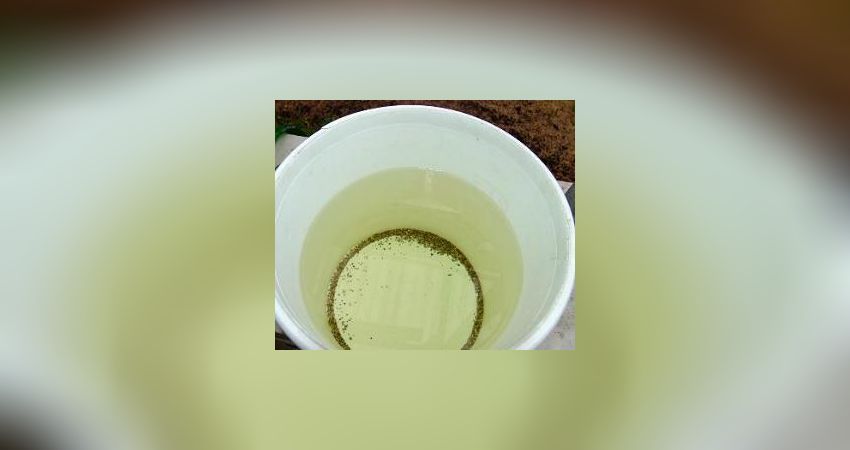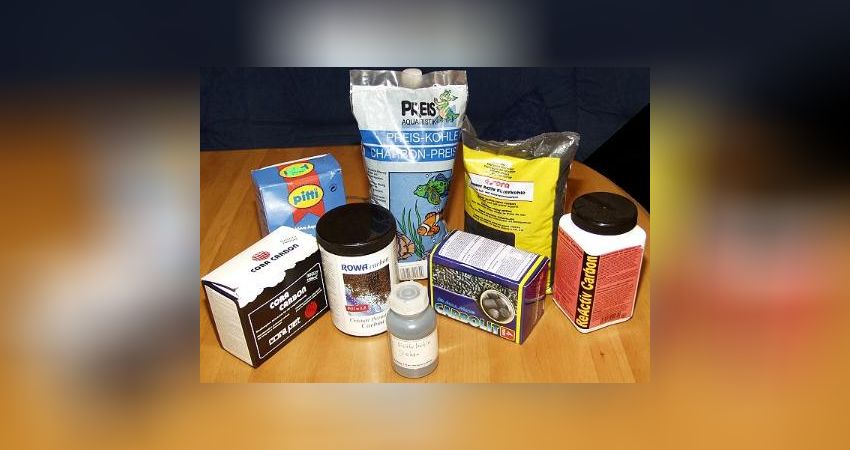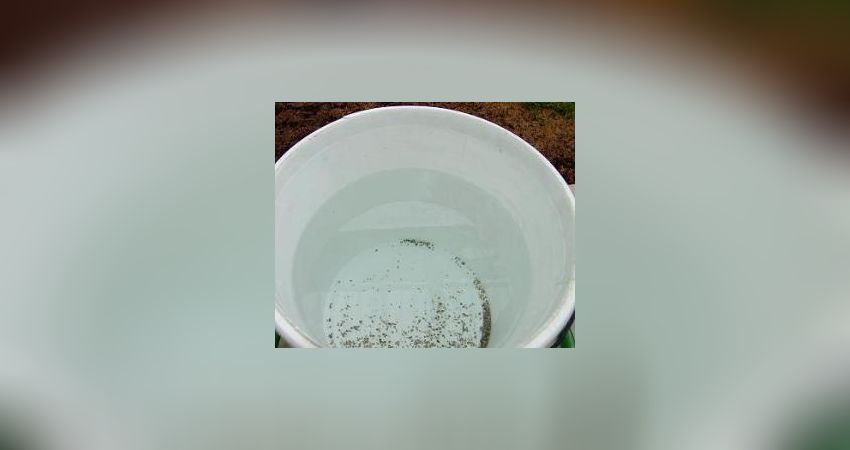20 - Activated carbon in the marine aquarium

viele Gelbstoffe
Why you should also think about carbon.... Removing the yellow substances common in seawater is an important and often underestimated topic
Activated carbon in the marine aquarium
After a few weeks and months at the latest, and with the arrival of fish and other animals, it becomes necessary at some point to think about the formation of yellow substances in the aquarium. Here there is the possibility of working with ozone, or if you don't want to do that, you can fall back on the good old-fashioned activated carbon. This is certainly also familiar to those who have switched from freshwater aquaristics.
viele Sorten Kohle
It is very easy to do a test yourself to see whether it is necessary to do something about any yellow substances that may occur. The best way to do this is to take two identical containers that should be pure white. Yoghurt pots, for example, or, as we want to illustrate in this case, the buckets that are used by one of the authors when changing the water, are ideal for this purpose.
[picture:white].
viele Gelbstoffe
klares Wasser
If you have yellow substances in the aquarium, you can see it immediately in the case, but this is usually not so easy to see in the aquairum without comparison. These yellow substances must be removed, as they deteriorate the water quality and also cost a lot of light. The clearer the water, the more light irradiation is possible, which is especially important for many flowering animals.
General information about carbon:
Activated carbon is made from peat, wood, brown coal, hard coal, nut shells (coconut shells). It is mainly used because of the yellow substances present in the aquarium. But regular filtration with carbon is not only important because of the yellow substances; it also removes growth-inhibiting substances (terpenes, alcohols) and other pollutants. In addition, it can be used after, for example, a medication treatment.
Adsorbtion:
Coal has the ability to remove substances from the water. This happens with activated carbon through adsorption. This adsorption is an accumulation of molecules on the large surface of the carbon, which can also be reversible. Namely, when other substances with a higher binding affinity approach the carbon. These then displace the previously bound substance groups with the lower binding affinity. This is to be distinguished from absorption, in which a chemical bond occurs and which is not reversible.
A fine filter should be installed upstream of the carbon filtration so that no suspended matter clogs the fine pores of the carbon!
In practice, this means that a carbon should not be supersaturated in continuous operation, but that short-term use is preferable. In our opinion, this is about 2 to 3 days, depending on the load on the water. The two authors always advise the use of a high-quality activated carbon!
But the most important thing in any case is to test regularly whether your water is still transparent, then you are on the safe side.
Frank Diehl, Robert Baur-Kruppas
How do you like this article?
Info
Author

Bookmark
Comments
Topics
Similar articles
- 24 - Horn corals or gorgonians
- 09 - The protein skimmer
- 01 - Sources of information
- How a marine aquarium is created Part 48-49: The new Maxspect Jump LEDs L165. 2 videos available
- 36 - Pests Part 1
- Photographing under blue light - 4 clip filters in comparison
- 12 - Start-up phase of a saltwater aquarium
- How a marine aquarium is created Part 34: Who eats our snails?
- How a seawater aquarium is created Part 33: Avoiding osmosis water flooding with Auto Aqua Smart ASOV
- How a marine aquarium is created-Part 23: The water level - drain problem in the marine aquarium
Comments To the top
nein musst Du meiner Ansicht nach nicht. Erst wenn Fische im Becken sind dann würde ich damit anfangen. Bei frischen Wasser halte ich das für eher nicht erforderlich.
Gruß Robert
ist das Becken komplett frisch? Was ist an Tieren drinn?
In einem frischen Becken sehe ich noch keine Notwendigkeit von Kohle oder Adsorber für Phosphat. Anders in bestehenden bereits gereiften Systemen. Um zu wissen ob man Gelbstoffe im Wasser hat kann man ja gut den hier beschriebenen Eimertest machen, sprich die Farben von frischem Wasser zu gebrauchten wasser abgleichen.
das Becken steht jetzt ca. 8 Monate. Vorher hatte ich 2 Jahre ein kleineres Becken.
Wie gesagt Kohle und Absorber laufen seit dem 1. Tag.
Besatz:
Fische
2x fridmani (King Salomon)
2x ocellaris black (Falscher Clown)
2x Macropharyngodon bipartitus (Diamant Lippfisch)
1x Synchiropus picturatus (LSD Mandarin)
1x Centropyge bicolor (Zwergkaiser)
1x Cryptocentrus cinctus (Zitronen-Wächtergrundel)
1x Nemateleotris decora (Dekor Schwertgrundel)
und einmal auch wenn er eigentlich zu groß ist aber in keinem Becken fehlen darf :) Zebrasoma flavescens (Hawaii Doktor)
Korallen:
4x Euphyllia
1x Catalaphyllia jardinei
1x Pocillopora damicornis
1x Busch grüne Krustenanemone
1x Scheibenanemone
4x Blasenanemone
3x Xenia elongata - Pumpkoralle
1x Lobophytum sp. 02 Fingerlederkoralle
1x Briareum hamrum - Grüne Röhrenkoralle
ein paar Bäumchenweichkorallen
sonstiges:
2x Weißbandputzergarnele
1x Partnergarnele
1x Knallkrebs
4x Einsiedlerkrebse
2x Nassarius luridus Schnecke
etwas Caluerpa, Drahtalge
und 4 Glasrosen :)
Leider ist mir gestern meine Tridacna maxima eingegangen. Habe zwar als ich gesehen habe das sie sehr viel Schleim absondert einen 20% WW gemacht aber...!Samstag erst ins Becken gesetzt und deswegen war ich am stöbern woran es lag und da bin ich auf die Kohle eventuell gekommen, nicht unbedingt das sie der Grund war warum die Muschel eingegangen ist aber das die Kohle eventuell das Wasser belastet.
350l, 3 Strömungspumpen, 1x Dennerle Nano Marinus Bio Circulator, 1x Filterschwamm, 1x Aqua Medic Turboflotor Blue 1000 wobei mir gerade auffällt das ich noch keinen UV-Klärer habe!?!??? :( und wie gesagt ne Rieselplatte und darunter sitzen die Behälter mit Activkohle und Phosphatbinder/absorber
Alle 2 Wochen einen 10% WW, Wasser wird über eine Osmoseanlage selber produziert. Zugaben wöchentlich 1x Bio Strontium Tropic Marin, 1x Reef Active Tropic Marin, 1-2x Coral Food Schwebefutter von Dupla, 1x Jod von Tropic Marin und je einmal von Tropic Marin 3ml Pro Coral K+ Elements und A- Elements.
Fütterung: Abends Frostfutter und Morgens etwas Futtergranulat von Naturefoods Größe M
Wasserwerte:
Nitrat: 1
Phophat: 0
Ca: 410
Mg: 1160
KH: 8
Vielleicht sollte ich mal über die Balling Methode nachdenken
Please register
In order to be able to write something yourself, you must register in advance.










